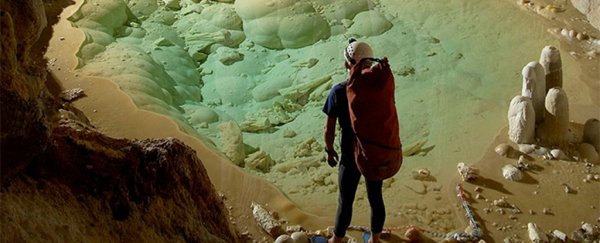Scientists have uncovered an ancient strain of bacteria called Paenibacillus in one of the deepest caves in the world - and it seems to be resistant to the most powerful antibiotics modern medicine can throw at it.
The bacteria have been hidden for more than 4 million years, suggesting that 'superbugs' can develop resistance to certain types of antibiotics without the influence of humans and our medicines - possibly through exposure to naturally occurring antibiotics in the underground environment.
The bacteria were discovered some 305 metres (or 1,000 feet) underground in the Lechuguilla Cave in New Mexico - an environment considered to be so pristine and scientifically important, you need to be part of a research team to gain access.
Scientists from the University of Akron in Ohio and McMaster University in Canada used cave samples to identify five specific pathways by which Paenibacillus blocks antibiotics, with the aim of helping us figure out how to beat that resistance in the future.
"We identified some unique mechanisms of resistance that haven't even emerged in bacteria that make us sick, which is exciting, because this means we have time to come up with potential mechanisms of resistance," explains researcher Hazel Barton from the University of Akron.
Antibiotics work by blocking the mechanisms that harmful bacteria use to function, but the problem is that these pathogens are rapidly evolving, and finding new mechanisms to replace the blocked ones faster than we can shut them down.
Adding to that problem is the fact that our increased use of antibiotics in hospitals and other industries, such as agriculture, seems to be helping antibiotic resistant pathogens evolve even more quickly.
That's part of the reason why this strain of ancient bacteria is of so much interest. It existed way before humans ever showed up, so its independent resistance appears to be down to some other kind of environmental pressure - we're just not sure what.
Tests showed that the bacteria were resistant to 18 different antibiotics, including daptomycin - used as 'last-resort' drug, when all others have failed.
The main defence used by Paenibacillus is producing mutations in individual cells that then get passed on to the next generation, which matches resistance methods used by similar species of bacteria found in soils.
At this stage, this hardy bacteria strain doesn't make humans sick, but if it evolves to become pathogenic - which can happen with or without human intervention - the team is hoping we'll have found a way to defeat it before it poses a health risk.
The researchers say that as the Lechuguilla Cave harbours ancient, drug-resistant bacteria, it might also contain the ingredients for new antibiotics we can make use of.
"That's the next step in this study," one of the team, Gerry Wright from McMaster University, told the Centre for Infectious Disease Research and Policy (CIDRAP) in Minnesota.
"The diversity of antibiotic resistance and its prevalence in microbes across the globe should be humbling to everyone who uses these life-saving drugs. It reflects the fact that we must understand that antibiotic use and resistance go hand-in-hand."
Unless we can stay one step ahead of these pathogens, antimicrobial resistance will become a huge problem for many surgeries and treatments in the future, making the cures for certain diseases just as risky as the diseases themselves.
Let's hope the world's brightest minds can find a solution before that happens.
The research has been published in Nature Communications.
